Sandy Wright's Blog, page 8
June 3, 2019
Game of Thrones Unanswered Questions
After nine years and eight seasons, Game of Thrones: The HBO Series, is finished.
I’ve watched the series multiple times and read all of the books, those finished to date. So…if you’d like to share your thoughts, by all means speak up.
Were you satisfied with the final season and the ending? Reviews are mixed from both fans and critics.
Personally, I loved it. And hated it.
 Game of Thrones was never going to have a “happy ever after” ending—we knew that from the time Ned Stark was beheaded. After following the series through the Red Wedding, King Joffrey’s short reign, Sansa’s rape, the Moon Door, execution by molten metal and dragon fire, and Arya creatively crossing people off her list, don’t tell me you thought we’d end with a royal wedding followed by Dany and Jon being co-rulers?
Game of Thrones was never going to have a “happy ever after” ending—we knew that from the time Ned Stark was beheaded. After following the series through the Red Wedding, King Joffrey’s short reign, Sansa’s rape, the Moon Door, execution by molten metal and dragon fire, and Arya creatively crossing people off her list, don’t tell me you thought we’d end with a royal wedding followed by Dany and Jon being co-rulers?
The biggest complaint I’ve heard this season was, “I hate what they did with Dany.” But I had no problems with Daenerys going full Mad Queen, I felt it was an appropriate character arc, and Jon Snow was the proper person to end her escalating destruction. It was the stuff of Greek tragedy—a man murdering his love for the greater good. And I loved the last dragon scenes, with Drogon melting the Iron Throne, although some fans think he was way too smart to decipher that throne as his mistress’s downfall.
George R.R. Martin used the English Wars of the Roses (1455-1487) as source material for A Song of Fire and Ice. But one commentator drew a parallel between Daenerys’ decision to burn King’s Landing, and Harry Truman’s decision to drop atomic bombs on Hiroshima and Nagasaki. Did either leader make the proper decision? I don’t know. But in both the actual and the fictional scenario, their action ended the war.
 The Stark’s split up (by choice this time), one to become king, two to return to the North, and Arya riding to new frontiers beyond the Kingdom was a great idea (and a potential spin-off?). Arya has always been one of my favorite characters. I’m glad she was the one to kill the Night King. She studied, trained and sacrificed to become a solo assassin, and when the situation called for a hero, she was ready.
The Stark’s split up (by choice this time), one to become king, two to return to the North, and Arya riding to new frontiers beyond the Kingdom was a great idea (and a potential spin-off?). Arya has always been one of my favorite characters. I’m glad she was the one to kill the Night King. She studied, trained and sacrificed to become a solo assassin, and when the situation called for a hero, she was ready.  I know, poor Jon, but he’s always loved the Wildlings, and he did kill the queen. It could have ended in complete tragedy, so count your blessings that he survived.
I know, poor Jon, but he’s always loved the Wildlings, and he did kill the queen. It could have ended in complete tragedy, so count your blessings that he survived.
As for Bran the Broken as King, this raven-lover actually predicted this ending, but not exactly in the way it happened.
Do you remember the episode mid-season, when everyone is waiting for the battle with the Night King to begin? Toward the end of that episode, Tyrion and Bran are together, and Tyrion comments that Bran must have learned so many interesting things in his travels, physical and astral. I fully expected Tyrion to relate some of Bran’s Three-Eyed-Raven foresight to Jon Snow. Information of the future that would help Jon in his decision to prevent Dany from carrying out her plans for the rest of the Kingdom.
That discussion never materialized. Again, at the final episode Council meeting, I expected Tyrion—or even better Bran Stark—to reveal Bran’s visions. The best way to move into the future is to look at the past, and he’s the one person who knows everything. It feels like he would be an incredibly fair ruler, if he would just talk a bit. But again, nothing. Dammit guys! You missed the perfect opportunity for closure here.
Again, at the final episode Council meeting, I expected Tyrion—or even better Bran Stark—to reveal Bran’s visions. The best way to move into the future is to look at the past, and he’s the one person who knows everything. It feels like he would be an incredibly fair ruler, if he would just talk a bit. But again, nothing. Dammit guys! You missed the perfect opportunity for closure here.
I think the final season moved too fast, leaving us agreeing with many of the character’s decisions, but feeling like those decisions were vaguely unjustified and unearned.
While the first six season had 10 episodes apiece, the show’s creators, D.B. Weiss and David Benioff, decided to shorten the final two seasons to seven and six episodes respectively. That decision left this viewer felling like they rushed toward the ending, including lavish (and expensive) battles, but without fully developing the character’s motivations. The outcomes could have been so much more powerful if the lead-ups had been stronger.
Please George R.R. Martin, give us closure!
Here are 12 things, big and small, I still want to know after the Game of Thrones HBO series ending:
How did the Unsullied know that Jon murdered Dany without a body? Did he confess?
Why did no one speak up about Jon’s family legacy? I know Jon didn’t want the throne. But it seemed downright weird that it wasn’t discussed at all by the High Council, after it was made such a BIG DEAL during this last season. What has happened to Robin Arryn between his sniveling baby boyhood and his brief appearance at the dragon pit? Is Ghost going to join Jon? Of course, everyone is rooting for this reunion. Throw us a crumb. And this time, have Jon hug the poor dog.
What has happened to Robin Arryn between his sniveling baby boyhood and his brief appearance at the dragon pit? Is Ghost going to join Jon? Of course, everyone is rooting for this reunion. Throw us a crumb. And this time, have Jon hug the poor dog.
Why did Bran walk out of his very first Council meeting? What’s so important about finding that dragon? Why did Sansa secede from the 7 Kingdoms? And more puzzling, why was she allowed to?
Why did Sansa secede from the 7 Kingdoms? And more puzzling, why was she allowed to?
Yara Greyjoy of the Iron Islands has been as fiercely independent and Sansa for the entire series. I was surprised she didn’t also ask to secede—or at least object to letting Sansa do so. Where is House Reed? We got to see Ned Stark’s friend Howland Reed when Bran Stark discussed them with the Three-Eyed Raven in a dream-scene. What happened to the family? Reed’s children, Jojen and Meera, risked their lives to help Bran on his mystical journey. We haven’t seen or heard from them since.
Where is House Reed? We got to see Ned Stark’s friend Howland Reed when Bran Stark discussed them with the Three-Eyed Raven in a dream-scene. What happened to the family? Reed’s children, Jojen and Meera, risked their lives to help Bran on his mystical journey. We haven’t seen or heard from them since.  Varys mentioned briefly before he was killed, that there’s a new prince of Dorne. He was one of several unidentified men who sat on the High Council in the last episode. I thought the Sand Snakes killed all the Dorne royalty, so who is he?
Varys mentioned briefly before he was killed, that there’s a new prince of Dorne. He was one of several unidentified men who sat on the High Council in the last episode. I thought the Sand Snakes killed all the Dorne royalty, so who is he?
And, while we're on the subject of Varys: he heard a voice in the flames a while back when a sorcerer used his body parts in ritual. We never got to hear what it said. I want to know about Jaqen H’ghar, the Faceless Man who taught Arya much of her craft.
I want to know about Jaqen H’ghar, the Faceless Man who taught Arya much of her craft.
He had some bad a$$ skills, and was one of my favorite characters, but then he just disappeared. What’s West of Westeros? Arya wondered this back in Season 6, and now that’s her destination. The only known voyage there in the books was led by Elissa Farman. Dany had her to thank for her dragon eggs, which Elissa stole from Dreamfyre to finance her trip. Elissa sailed west and was never seen again, although her ship was spotted many years later.
The only known voyage there in the books was led by Elissa Farman. Dany had her to thank for her dragon eggs, which Elissa stole from Dreamfyre to finance her trip. Elissa sailed west and was never seen again, although her ship was spotted many years later.  f Samuel Tarly helped Archmaester Embrose write “A Song of Ice and Fire,” why wouldn’t Tyrion be mentioned?
f Samuel Tarly helped Archmaester Embrose write “A Song of Ice and Fire,” why wouldn’t Tyrion be mentioned?
Game of Thrones became a global phenomenon by upending expectations. The noble patriarch defined by his morals? Beheaded in the first season. His valiant son who led with his heart? Slaughtered along with his wife and dedicated mother. An inquisitive young boy who loved to climb? Thrown to the ground by an uncaring royal in the middle of a tryst with his sister.
We got brutally honest depictions of the worst in human nature, and occasionally also the best.
This was a Shakespearean saga about power, blood, loyalty and magic, eight brilliant seasons of mesmerizing entertainment. Even with its flaws, I can honestly say my life and my imagination are richer for watching.
See you next weekend. Blessed Be.
I’ve watched the series multiple times and read all of the books, those finished to date. So…if you’d like to share your thoughts, by all means speak up.
Were you satisfied with the final season and the ending? Reviews are mixed from both fans and critics.
Personally, I loved it. And hated it.
 Game of Thrones was never going to have a “happy ever after” ending—we knew that from the time Ned Stark was beheaded. After following the series through the Red Wedding, King Joffrey’s short reign, Sansa’s rape, the Moon Door, execution by molten metal and dragon fire, and Arya creatively crossing people off her list, don’t tell me you thought we’d end with a royal wedding followed by Dany and Jon being co-rulers?
Game of Thrones was never going to have a “happy ever after” ending—we knew that from the time Ned Stark was beheaded. After following the series through the Red Wedding, King Joffrey’s short reign, Sansa’s rape, the Moon Door, execution by molten metal and dragon fire, and Arya creatively crossing people off her list, don’t tell me you thought we’d end with a royal wedding followed by Dany and Jon being co-rulers?The biggest complaint I’ve heard this season was, “I hate what they did with Dany.” But I had no problems with Daenerys going full Mad Queen, I felt it was an appropriate character arc, and Jon Snow was the proper person to end her escalating destruction. It was the stuff of Greek tragedy—a man murdering his love for the greater good. And I loved the last dragon scenes, with Drogon melting the Iron Throne, although some fans think he was way too smart to decipher that throne as his mistress’s downfall.
George R.R. Martin used the English Wars of the Roses (1455-1487) as source material for A Song of Fire and Ice. But one commentator drew a parallel between Daenerys’ decision to burn King’s Landing, and Harry Truman’s decision to drop atomic bombs on Hiroshima and Nagasaki. Did either leader make the proper decision? I don’t know. But in both the actual and the fictional scenario, their action ended the war.
 The Stark’s split up (by choice this time), one to become king, two to return to the North, and Arya riding to new frontiers beyond the Kingdom was a great idea (and a potential spin-off?). Arya has always been one of my favorite characters. I’m glad she was the one to kill the Night King. She studied, trained and sacrificed to become a solo assassin, and when the situation called for a hero, she was ready.
The Stark’s split up (by choice this time), one to become king, two to return to the North, and Arya riding to new frontiers beyond the Kingdom was a great idea (and a potential spin-off?). Arya has always been one of my favorite characters. I’m glad she was the one to kill the Night King. She studied, trained and sacrificed to become a solo assassin, and when the situation called for a hero, she was ready.  I know, poor Jon, but he’s always loved the Wildlings, and he did kill the queen. It could have ended in complete tragedy, so count your blessings that he survived.
I know, poor Jon, but he’s always loved the Wildlings, and he did kill the queen. It could have ended in complete tragedy, so count your blessings that he survived. As for Bran the Broken as King, this raven-lover actually predicted this ending, but not exactly in the way it happened.
Do you remember the episode mid-season, when everyone is waiting for the battle with the Night King to begin? Toward the end of that episode, Tyrion and Bran are together, and Tyrion comments that Bran must have learned so many interesting things in his travels, physical and astral. I fully expected Tyrion to relate some of Bran’s Three-Eyed-Raven foresight to Jon Snow. Information of the future that would help Jon in his decision to prevent Dany from carrying out her plans for the rest of the Kingdom.
That discussion never materialized.
 Again, at the final episode Council meeting, I expected Tyrion—or even better Bran Stark—to reveal Bran’s visions. The best way to move into the future is to look at the past, and he’s the one person who knows everything. It feels like he would be an incredibly fair ruler, if he would just talk a bit. But again, nothing. Dammit guys! You missed the perfect opportunity for closure here.
Again, at the final episode Council meeting, I expected Tyrion—or even better Bran Stark—to reveal Bran’s visions. The best way to move into the future is to look at the past, and he’s the one person who knows everything. It feels like he would be an incredibly fair ruler, if he would just talk a bit. But again, nothing. Dammit guys! You missed the perfect opportunity for closure here.I think the final season moved too fast, leaving us agreeing with many of the character’s decisions, but feeling like those decisions were vaguely unjustified and unearned.
While the first six season had 10 episodes apiece, the show’s creators, D.B. Weiss and David Benioff, decided to shorten the final two seasons to seven and six episodes respectively. That decision left this viewer felling like they rushed toward the ending, including lavish (and expensive) battles, but without fully developing the character’s motivations. The outcomes could have been so much more powerful if the lead-ups had been stronger.
Please George R.R. Martin, give us closure!
Here are 12 things, big and small, I still want to know after the Game of Thrones HBO series ending:
How did the Unsullied know that Jon murdered Dany without a body? Did he confess?
Why did no one speak up about Jon’s family legacy? I know Jon didn’t want the throne. But it seemed downright weird that it wasn’t discussed at all by the High Council, after it was made such a BIG DEAL during this last season.
 What has happened to Robin Arryn between his sniveling baby boyhood and his brief appearance at the dragon pit? Is Ghost going to join Jon? Of course, everyone is rooting for this reunion. Throw us a crumb. And this time, have Jon hug the poor dog.
What has happened to Robin Arryn between his sniveling baby boyhood and his brief appearance at the dragon pit? Is Ghost going to join Jon? Of course, everyone is rooting for this reunion. Throw us a crumb. And this time, have Jon hug the poor dog.Why did Bran walk out of his very first Council meeting? What’s so important about finding that dragon?
 Why did Sansa secede from the 7 Kingdoms? And more puzzling, why was she allowed to?
Why did Sansa secede from the 7 Kingdoms? And more puzzling, why was she allowed to? Yara Greyjoy of the Iron Islands has been as fiercely independent and Sansa for the entire series. I was surprised she didn’t also ask to secede—or at least object to letting Sansa do so.
 Where is House Reed? We got to see Ned Stark’s friend Howland Reed when Bran Stark discussed them with the Three-Eyed Raven in a dream-scene. What happened to the family? Reed’s children, Jojen and Meera, risked their lives to help Bran on his mystical journey. We haven’t seen or heard from them since.
Where is House Reed? We got to see Ned Stark’s friend Howland Reed when Bran Stark discussed them with the Three-Eyed Raven in a dream-scene. What happened to the family? Reed’s children, Jojen and Meera, risked their lives to help Bran on his mystical journey. We haven’t seen or heard from them since.  Varys mentioned briefly before he was killed, that there’s a new prince of Dorne. He was one of several unidentified men who sat on the High Council in the last episode. I thought the Sand Snakes killed all the Dorne royalty, so who is he?
Varys mentioned briefly before he was killed, that there’s a new prince of Dorne. He was one of several unidentified men who sat on the High Council in the last episode. I thought the Sand Snakes killed all the Dorne royalty, so who is he?And, while we're on the subject of Varys: he heard a voice in the flames a while back when a sorcerer used his body parts in ritual. We never got to hear what it said.
 I want to know about Jaqen H’ghar, the Faceless Man who taught Arya much of her craft.
I want to know about Jaqen H’ghar, the Faceless Man who taught Arya much of her craft.He had some bad a$$ skills, and was one of my favorite characters, but then he just disappeared. What’s West of Westeros? Arya wondered this back in Season 6, and now that’s her destination.
 The only known voyage there in the books was led by Elissa Farman. Dany had her to thank for her dragon eggs, which Elissa stole from Dreamfyre to finance her trip. Elissa sailed west and was never seen again, although her ship was spotted many years later.
The only known voyage there in the books was led by Elissa Farman. Dany had her to thank for her dragon eggs, which Elissa stole from Dreamfyre to finance her trip. Elissa sailed west and was never seen again, although her ship was spotted many years later.  f Samuel Tarly helped Archmaester Embrose write “A Song of Ice and Fire,” why wouldn’t Tyrion be mentioned?
f Samuel Tarly helped Archmaester Embrose write “A Song of Ice and Fire,” why wouldn’t Tyrion be mentioned? Game of Thrones became a global phenomenon by upending expectations. The noble patriarch defined by his morals? Beheaded in the first season. His valiant son who led with his heart? Slaughtered along with his wife and dedicated mother. An inquisitive young boy who loved to climb? Thrown to the ground by an uncaring royal in the middle of a tryst with his sister.
We got brutally honest depictions of the worst in human nature, and occasionally also the best.
This was a Shakespearean saga about power, blood, loyalty and magic, eight brilliant seasons of mesmerizing entertainment. Even with its flaws, I can honestly say my life and my imagination are richer for watching.
See you next weekend. Blessed Be.
Published on June 03, 2019 22:37
May 26, 2019
Mockingbird Music
 It’s 2:00 am, and through my open bedroom window, it sounds like a dozen different birds are singing in our back yard, all performing one at a time. But no, it’s not a bird chorus, it’s our friend the mockingbird, looking for love.
It’s 2:00 am, and through my open bedroom window, it sounds like a dozen different birds are singing in our back yard, all performing one at a time. But no, it’s not a bird chorus, it’s our friend the mockingbird, looking for love.He has lived in our back yard for years, but he’s especially vocal this spring for some reason. As in he never shuts up. Day and night. All night. I have to have my Google mini play ocean noises, or sometimes, thunderstorms, just to drown him out so I can get to sleep. Since mockingbirds are monogamous and pair for life, I’m rooting for a summer wedding so he’ll calm down.
A mockingbird can learn up to 200 songs and noises in its life, which males arrange into different set lists for fall or spring. They’re among the world’s best mimids—a family of birds known for uncanny mimicry skills. They normally imitate fellow birds like jays, hawks, and, in our guy’s case, mourning doves. Experts say they can’t mimic a dove. I say they need to spend a day in our back yard.
Sometimes the clever fellows branch out to echo other familiar sounds, from frogs’ croaks, to creaky doors and car alarms. My friend’s repertoire includes dog barks and something close to a cat’s meow, which he intersperses in his long, strung-together series of calls.
Although most bird species only learn songs during a critical period in their youth, mockingbirds are considered open-ended learners, meaning that they learn new songs throughout their lives. Parrots and European Starlings are examples of other open-ended learners.
This unique ability made the mockingbird a popular cages bird, and by the early 20th century it was nearly extinct in large cities in America. Today it has nearly recovered in these areas, and is in fact experiencing range expansion due to human activities, such as the planting of multiflora roses.
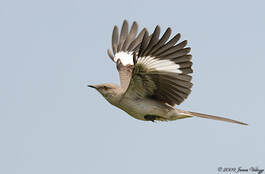 The Northern Mockingbird is medium-sized, gray in color with white wing patches and a white underside. When I see a flash of white in our back yard, I know it’s the mockingbird spreading its wings to show off.
The Northern Mockingbird is medium-sized, gray in color with white wing patches and a white underside. When I see a flash of white in our back yard, I know it’s the mockingbird spreading its wings to show off. 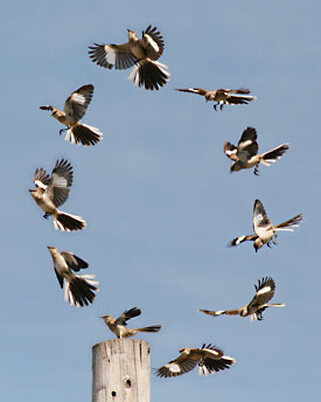 He also perches on the light pole in the front yards and does acrobatics (see the time-lapse photo) that look like he’s doing a somersault. What a clown.
He also perches on the light pole in the front yards and does acrobatics (see the time-lapse photo) that look like he’s doing a somersault. What a clown.Both sexes sing, but males are more conspicuous. An unpaired male may sing 24 hours a day in the breeding season—spring to early summer—especially during a full moon.
A pair of mockingbirds will have 2-3 broods per year. They build the nest in trees or shrubs and the females lays up to 6 greenish eggs splotches with reddish brown spots. The male is very defensive and aggressive of his nest. The one in our backyard will dive bomb our 18-pound cats to keep them away from his nest.
While my friend is noisy, he’s entertaining, and he also helps keep down the bug and spider population. In Arizona, mockingbirds also eat a variety of fruits, as well as the berries of lantana, pyracantha, and desert hackberry. I suspect he may also be the culprit who pecks holes in my pomegranate fruit and cleans out the insides.
 In bird magic, the mockingbird is here to teach you about the power of song and voice. It can help you learn new languages and sing them as naturally as if you were born to them. Mockingbird can help you realize your inner talents and sing them for. It can help you find your own sacred song in life.
In bird magic, the mockingbird is here to teach you about the power of song and voice. It can help you learn new languages and sing them as naturally as if you were born to them. Mockingbird can help you realize your inner talents and sing them for. It can help you find your own sacred song in life.I’m not going to get mad at my noisy outside neighbor while he searches for a woman. Instead I’ll lie in bed in the early morning hours and try to count the number of times his song changes. Try to think of him as loud but lovable. And if all else fails…close the windows and turn up the sound machine, knowing this is hormonally-driven behavior that will stop soon.
Blessed Be to the birds and the bees. And to you!
Published on May 26, 2019 12:44
May 10, 2019
Flowers on Your Plate
 Floral centerpieces on the dinner table are a classic and timeless tradition, but flowers can show up on your dinner plate also.
Floral centerpieces on the dinner table are a classic and timeless tradition, but flowers can show up on your dinner plate also.The culinary use of flowers dates back thousands of years to the Chinese, Greek and Romans. Many cultures use flowers in their traditional cooking—think of squash blossoms in Italian food and rose petals in Indian food. At least one medieval feast used marigolds to season the venison, and violets mingled with onion in the salad—making that long-ago meal sound quite modern!
Adding flowers to your food can be a nice way to add color, flavor and a little whimsy. Some are spicy, some herbal, while others are floral and fragrant. The range is surprising.
Flowers can be eaten as a main dish or be incorporated into salads. They can be added to beverages or ice cubes, or infused to make cocktails and wines. They are added to spreads such as butter or fruit preserves, and to vinegar and dressings.
Here, in time for your summer parties, is a guide to my 10 favorite edible florets.
 Alliums (leeks, chives, garlic, garlic chives)
Alliums (leeks, chives, garlic, garlic chives)Known as “Flowering Onions.” There are nearly 400 species that includes the familiar onion, garlic, chives, ramps and shallots. All members of this genus are edible. Flavors range from mild onion to strong garlic. All parts of the plants are edible. My favorite is the Garlic Blossom ((Allium satifum). The flowers can be white or pink, and the stems are flat instead of round. The flavor has a garlicky zing, milder than the garlic bulb, and wonderful in salads.
 Borage Blossoms (Borago officinalis)
Borage Blossoms (Borago officinalis)
These beautiful blue, star-shaped flowers taste a bit like cucumber. They’ve been used in salads since the Elizabethan Age. They’re also delicious in lemonade and cocktails like gin and tonic.
 Calendula (Calendula officinalis)
Calendula (Calendula officinalis)
Known as pot marigolds, and the “poor man’s saffron,” the sunset-hued marigold flower really does taste like saffron when it’s sautéed in olive oil to release its flavor.
Uncooked marigold petals have a more subtle, slightly spicy taste and add depth to deviled eggs. Cut the petals off the flower and dry them in a warm (100 degree) oven. Sprinkle the crushed petals on cheese dishes, omelets and rice. Note: Only the petals are edible.
 Carnation (Dianthus spp.)
Carnation (Dianthus spp.)Carnations (aka Dianthus) can be steeped in wine, candy, or used as a cake decoration. To use the surprising sweet petals in desserts, cut them away from the bitter white base of the flower.
Dianthus are the miniature member of the carnation family with light clove or nutmeg-like scent. Petals add color to salads. You can also add them to cake mixes, candies (especially chocolate) and teas. Or sprinkle minced fresh petal over a bowl of berries.
Carnation petals are one of the secret ingredients used to make Chartreuse, a French liqueur, since the 17th century.
 Hibiscus
Hibiscus
Both tart and sweet, hibiscus petals have a cranberry-like flavor that makes them perfect for tea and cocktails. Drop fresh buds into glasses of bubbly and let your guests watch them bloom before their eyes.
 Lavender
Lavender (Lavandula angustifolia)
Lavender works well when the buds are sprinkled in cocktails and over desserts like chocolate cake. It’s delicious in tea or infused in sauces and ice cream. You can also sprinkle a bit on salads.
Lavender also lends itself savory dishes, from stew to wine-reduced meat sauces. The diminutive blooms add a mysterious cent to custards, flans or sorbets. Note: Do not consume lavender oil unless you absolutely know it has not been sprayed and is culinary safe.
 Nasturtium (Tropaeolum majus)
Nasturtium (Tropaeolum majus)These gorgeous flowers have a slightly peppery taste, almost like watercress. This photo shows them used in a summer rice paper roll. You can also stuff a whole flower with savory mousse or beef carpaccio.
They also look beautiful floating in a tureen of soup of bowl of punch. Try “Empress of India” for its deep red-orange flowers and dark blue-green leaves, which add a sweet mustard flavor to salads. Be sure to remove the spur behind the blossom, as it may shelter insects.
 Rose (Rosa rugosa or R. gallica officinalis)
Rose (Rosa rugosa or R. gallica officinalis)Roses have a strong floral scent, but their flavor is subtle and fruity. They go well in everything from soups and salads to teas, jam and desserts.
Flavors depend on type, color and soil conditions. Some are reminiscent of strawberries and green apple.
The lighter flowers have a mild flavor; the darker a rose’s color, the more likely that it will have a strong metallic taste.
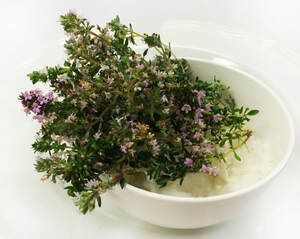 Thyme (Thymus spp)
Thyme (Thymus spp)The tiny pink or lavender flowers on this herb are often overlooked in favor of its aromatic leaves.
The lavender flowers of French thyme (T. volgaris) can be sprinkled on top of baked mushroom caps, while the pink flowers of lemon thyme (T.citriodorus) add a citrusy zing.
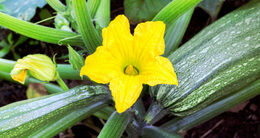
 Zucchini Blossoms (Cucurbita pepo var. cylindrical)
Zucchini Blossoms (Cucurbita pepo var. cylindrical)
The bright yellow flowers of this vegetable plant have a delicate and slightly sweet taste. Use them stuffed with cheese, bacon and mushrooms as a flavorful and fun appetizer. Note: If you want squash vegetables also this summer, harvest only male flowers to eat.
Do’s and Don’ts
Before consuming any plant or flower, identify the flower exactly and only eat the edible parts of those flowers.
Use flowers sparingly in your recipes when you first try them. Too much of a good thing may cause problems for your digestive system.
Remove pistils and stamens from flowers before eating. Separate the flower petals from the rest of the flower just prior to use to keep wilting to a minimum.
Don’t use flowers that have been sprayed with pesticides or other chemicals. Always purchase your edible flowers from the product section of your grocery store, or from online sources. Try The Chef’s Garden or Gourmet Sweet Botanicals.
Clean edible flowers by washing them gently in a large bowl of cold water and letting them air dry on a paper towel. Serve immediately or store in the refrigerator for up to 2 days in an airtight container lined with a damp paper towel.
Just because flowers are served with food at a restaurant does not mean they are edible. Know your edible flowers!
Until next week, good eating!
Published on May 10, 2019 23:59
April 28, 2019
Lusty Beltane
 “Over here, Seamus,” the raven-haired young woman called out to her companion, surveying the multicolored spring flowers in a small clearing in the trees. “There are hundreds of them! Beautiful!”
“Over here, Seamus,” the raven-haired young woman called out to her companion, surveying the multicolored spring flowers in a small clearing in the trees. “There are hundreds of them! Beautiful!”A tall young man with flame-red hair came rushing to Caitlin’s side. “Indeed, my darling,” he said, his eyes locked on her breasts, “they are indeed beautiful.”
Caitlin giggled, blushing. “The flowers, Seamus,” she said, sweeping her hand to show him the scene before them.
 Photo by J.J. Raia Photo
Photo by J.J. Raia Photo“Those are nice, too,” he said, slipping an arm around her waist.
She took his hand and led him into the center of the little grove. “Come on now,” she said, setting down the large baskets she’d been carrying.” We have to collect them for tomorrow’s May Day celebration.”
“Aye,” he agreed, “for tomorrow. Which means we have all night.”
Caitlin laughed as Seamus moved closer. “I suppose you’re right,” she said, her voice becoming thick with emotion as she touched his arm and raised her eyes to meet his. “And with this many, we need not look further. These will fill our baskets with much to spare.”
“Let’s crush a few, then,” Seamus said with a sly smile, slipping both arms around Caitlin’s waist this time. “I mean, how else will we know if they smell good?”
She looked into his clear hazel eyes, which were shining with desire for her, as her own body began to sing with an equal desire.“True enough, my love,” she said as Seamus pulled her closer. “For surely it would be insulting to the gods to bring in the May with imperfect flowers.”
~Thuri Calafia, Sabbats Almanac
Ah, intoxicating, lusty, sensual Beltane, the Sabbat of love.
Beltane is the sweet yang to Samhain’s dark yin—a joyous celebration of life and sexuality. Yes, there’s a reason why it’s one of the most popular wedding months.
The followers of the Old Ways met on mountaintops and danced the spiral dance on the night before Beltane, called Walpurgis Night. The ancients believed that the earth appreciated the sexual energy expended in her open fields, that it stimulated the fertility of the crops and animals.
 Artist Maxine Miller
Artist Maxine MillerThe original purpose of Walpurgisnacht, as the Teutons called it, was to beseech the Horned God, Cernunnos. One of the two primordial nature gods in central and western Europe, he embodies the vitality of animal life, just as the Green Man, who is seen in many current festivals today, represents the surge of vegetation in the spring.
Walpurgis Night was originally a hunt ceremony in which the tribe prayed for an abundance of deer and elk to be born now, to grow fat by Hunter’s moon in October, then feed the people through the winter.
The crucial step in the rites of the Horned One was to address prayers to the spirits of the horned animals who would be giving their lives in the months to come, to bless their sacrifice and ask their forgiveness from the clan’s hunters.
The next night farmers would drive their cattle between two sacred fires, called “need fires” to bring luck, fertility, and an abundant milk yield for the year.
 Probably the best known Beltane tradition is the Maypole dance. Dancing the maypole is a symbolic Beltane tradition that honors the sacred marriage of the Lord and the Lady, and the lush abundance of our world. The pole itself symbolizes the Lord’s phallus, pointing up to the sky, and the ribbons twined around it represent the Lady, as does the ring of flowers at the top, which gradually descends deeper on the pole as the dancers twirl.
Probably the best known Beltane tradition is the Maypole dance. Dancing the maypole is a symbolic Beltane tradition that honors the sacred marriage of the Lord and the Lady, and the lush abundance of our world. The pole itself symbolizes the Lord’s phallus, pointing up to the sky, and the ribbons twined around it represent the Lady, as does the ring of flowers at the top, which gradually descends deeper on the pole as the dancers twirl.There is so more I could share about Beltane, one of my favorite Sabbats. But I had eye surgery this week and am limiting my computer time to give my eye a chance to heal.
Until next time…Happy Beltane and Blessed Be.
Published on April 28, 2019 20:45
April 21, 2019
13 Creepy Scorpion Facts
 I had the unpleasant experience of being stung in my bed by a scorpion last weekend. Three times, in fact, before I could get out of my nightgown and underwear.
I had the unpleasant experience of being stung in my bed by a scorpion last weekend. Three times, in fact, before I could get out of my nightgown and underwear. Let me just say upfront: the “Harm none” doctrine does not apply to poisonous arthropods. Especially not when they come into my house, crawl into my BED, and attack me. We immediately got the black light and found him. He’s now on to the next life.
We are now going out into the yard to hunt his relatives every night until all scorpions are gone. It will take constant vigilance. They’re sneaky and prolific little creatures, and we’ve been finding them in the backyard for years. But—my bed, my place of peace and refuge—that’s crossing a line that cannot be forgiven. This is war.
Because I wanted to know exactly what we’re up against, I researched scorpions for my blog this week. The result is these 13 fascinating facts about scorpions, the Arizona bark scorpion specifically.
1 – Arizona is home to an especially nasty type of scorpion
The bark scorpion is found throughout Arizona, in the extreme southeastern portion of California near Arizona, and in southwestern New Mexico. In Mexico, the bark scorpion is found in Baja California Norte, Baja California Sur, and Sonora.
They reach a length of 3 inches and have a very thin tail only 1/16 inch wide; the body is yellow without stripes or patterns. The bark scorpion is the only common climbing scorpion and does not normally burrow but usually lives above ground under tree bark, in palm trees, and crevices of rocky cliffs or walls. Because it can climb block walls or stucco, this species is the scorpion most likely to enter dwellings.
2. Scorpions come out at night. Nocturnal creatures, scorpions find shelter during the day. They emerge to feed after dark and cease activity sometime before dawn.
 3. Scorpions glow in the dark. For reasons that scientists are still debating, scorpions glow under ultraviolet light. A scorpion’s cuticle, or skin, absorbs ultraviolet light and reflects it as visible light. At night, they glow a vibrant green under a black light. On a moonless night, scorpions can be seen at distances up to 30 feet. If you have scorpions on your property and want to freak yourself out, go hunting with a black light in a dark back yard. The little suckers will light up like green glow sticks.
3. Scorpions glow in the dark. For reasons that scientists are still debating, scorpions glow under ultraviolet light. A scorpion’s cuticle, or skin, absorbs ultraviolet light and reflects it as visible light. At night, they glow a vibrant green under a black light. On a moonless night, scorpions can be seen at distances up to 30 feet. If you have scorpions on your property and want to freak yourself out, go hunting with a black light in a dark back yard. The little suckers will light up like green glow sticks.4. Scorpions are attracted to moisture around pools, kitchen cabinets and sinks, and the bathroom/toilet. I lifted the soap dish from my kitchen sink last summer to clean it, and jumped half-way across the room when a scorpion scuttled from underneath the dish.
Scorpions also may be found in stacked lumber or bricks, firewood piles, cellars, and attics. It needs only a crack of 1/16 inch to enter a home. 5. Arizona’s bark scorpions can stick to the undersurface of objects and climb walls. For instance, a seemingly normal rock in a garden, may have a scorpion clinging to its undersurface. It’s not enough to raise that rock and check the ground below it. Always check the bottom side as well, to avoid becoming an easy target.
The bark scorpion is also the only type in the world that can climb up walls and hide on the ceiling, the back of curtains and other vertical surfaces. Yes, I have found one on the ceiling—on the second story of my home, no less.
6. The bark scorpion is the most venomous scorpion in North America. Its venom can cause severe pain coupled with numbness, tingling, loss of breath, even dysfunction of the area stung, e.g, a hand or arm can be immobilized or experience convulsions. Due to the extreme pain induced, many victims describe sensations of electrical jolts as the venom moves around through the body. I can attest to both severe pain, including electrical jolts, and to a buttock and leg that jerked involuntarily for hours. The major effects normally wear off in 12-24 hours, although the sting site may still be sore.
The good news: a scorpion sting, even one from the bark scorpion, does not always require a trip to the emergency room. Keep the sting victim calm and relaxed, and don’t allow him/her to consume alcohol or sedatives, although ibuprofen for the pain is ok. Clean the sting site with soap and water, and then apply an ice pack. Capture the scorpion for identification if you can do so safely. Fortunately, antivenom is available to treat more severe reactions, such as difficulty breathing, vomiting or swelling of the throat.
Of course, the best course of action is to avoid being stung by a scorpion in the first place. Don’t leave shoes, boots, clothing items, or damp pool towels outdoors where scorpions can hide. Shake all clothing and shoes before putting them on. Wear gloves when working in the yard, and wear shoes outdoors, especially during evening hours. A portable black light (UV light) may be used to check for scorpions in and around the home.
7. An antivenom was developed for the bark scorpion at Arizona State University by Dr. Herbert L. Stahnke, and produced in quantities sufficient to treat individuals within the state of Arizona. While this antivenom was not FDA approved, it was quite effective. Production of this antivenom ceased by 2000. A Mexican company, Laboratorio Silanes, developed a new antivenom named Anascorp and received FDA approval in 2011; that is what is now used.
 Mother scorpion with babies.
Mother scorpion with babies.Photo by Joe Phillips 2009
8. Scorpions give birth to live young. Unlike insects, which generally deposit eggs outside their bodies, scorpions produce live babies. The gestational stage is several months, and litters of 25-35 young is not uncommon. After birth, the newborns ride on their mother’s back for protection until they molt for the first time, about three weeks after birth. While the bigger the scorpions look scarier, newborn scorpions are more venomous and deadly than the adults because the baby scorpions cannot control the amount of venom they inject per sting.
9. Scorpions have long lifespans. In the wild, scorpions typically live from 2-10 years; in captivity they live up to 25 years!
10. Scorpions can survive almost anything. They can live for a full year without food. Because they have book lungs (like horseshoe crabs), they can stay submerged underwater for up to 48 hours and survive, so don’t brush them into your pool to kill them! They can live on only the moisture they obtain from their food, and they have extremely low metabolic rates and require only a tenth of the oxygen of most insects. Some species can be super cooled below the freezing point for weeks, yet return within hours to normal levels of activity. Conversely, desert scorpions can withstand temperatures of 47 °C (117 °F), which is several degrees higher than the lethal temperatures for other desert arthropods.
What that means for us humans is that scorpions don’t die out seasonally, they simply adjust their living quarters. If you’re fighting scorpions in your home, you may feel they are virtually indestructible, and with good reason. During US nuclear testing, scorpions, along with cockroaches and lizards, were found near ground zero with no recorded effects.
11. Scorpions eat just about anything they can subdue and consume. They prey on insects, spiders, and other arthropods, grubs, and earthworms. Larger scorpions can eat larger prey and are known to feed on small lizards and mice. A hungry mother scorpion will eat her own babies if resources are scarce.
Scorpion’s large pincers are studded with highly sensitive tactile hair, and the moment an insect touches these, it uses its chelae (pincers) to catch the prey. The prey is stung if it is relatively large, aggressive, or active. Otherwise the scorpion simply holds it and eats it alive. The chelicerae are toothed, and with these tools the scorpion chews the prey as quantities of digestive fluids secreted from the midgut pour over it. The victim’s soft parts are broken down, liquefied, and sucked into the scorpion’s stomach by a pumping action. The victim is gradually reduced to a ball of indigestible material, which is cast aside. Eating is a slow process, often taking many hours.
12. Scorpions are ancient organisms. If you traveled back in time 300 million years, you would encounter scorpions that look remarkably similar to their descendants living today. Fossil evidence shows scorpions from the Carboniferous period. The very first scorpions likely lived in the seas, and may even have had gills. By the Silurian period, 420 million years ago, they had
 Constellation Scorpius
Constellation Scorpius13. Scorpions are found throughout mythology and astronomy. In Babylonian mythology, the Scorpion Men were fearsome warriors. They were the children of Tiamat, the mother-dragon of the universe. Half-man and half-scorpion, they had human heads and arms and were scorpions from the waist down, with powerful tails that they used in combat. They also fought with their bows and arrows, which never missed. The Babylonians believed the Scorpion Men were the sacred guardians of their sun god, Shamash.
In a Greek legend, Orion was a follower of Artemis, the goddess of the hunt. Eventually, Orion is said to have raped one of Artemis' female companions, and she decided to kill him for it. Artemis sent the Scorpion after Orion, which tracked him down and killed him with his sting. Orion was then given a place among the stars, far away from the Scorpion to keep him safe. You can still see the constellation of Scorpio rising just as Orion is setting on the western horizon!
In Greek mythology Scorpius represents a scorpion that was sent into the heavens after being killed by the great hunter Orion. The scorpion was sent to destroy Orion by Gaia the Goddess of Earth after the great hunter grew arrogant of his powers.
Following the scorpion’s placement amongst the stars another myth grew involving Phaeton, the mortal son of the Sun God Helios. Each day Helios rode his sun chariot around the Earth bringing light and warmth to the world. One day Helios allowed Phaeton to drive the chariot with disastrous consequences. Phaeton drove the chariot too high which froze the Earth. As he rose higher in the sky he neared Scorpius, the creature reacted by raising its sting, noticing that the scorpion was about to attack Phaeton steered the chariot back towards Earth. Unfortunately he got too close and as a result set fire to the land, turning parts of the Earth into desert.
Scorpius is a large and bright constellation which is mainly visible in the southern hemisphere. In the Northern hemisphere the constellation can be seen in July and August, low on the horizon.
I hope you don’t have any up-close-and-way-too-personal encounters with scorpions like I had. But if you do, you will now be prepared. Let me know if you learned anything new in this blog about the creepy critters that glow in the dark.
Next week I’ll move onto more enjoyable topics, sex, love and pagan rites of fertility—Beltane!
Until then, Blessed Be. And wear your flip-flops when venturing outside after dark!
Published on April 21, 2019 23:04
April 10, 2019
Shadow Study Workbook
 As promised, here are some concluding questions to ponder during your personal shadow work. (I posted the first 10 exercises in my last blog).
As promised, here are some concluding questions to ponder during your personal shadow work. (I posted the first 10 exercises in my last blog).Exercise #11- Secrecy
What parts of yourself do you keep hidden from your friends and loved ones? Explore why below.
Exercise #12- The Victim
Explore how you play out the following role in real life: The Victim (other names: slave, martyr). If you have been genuinely victimized in life, it’s important that you own the title of victim. But when you create an identity surrounding your victimhood, then you suffer tremendously. The biggest problem that the inner victim brings to our lives is self-pity and disowned personal power. When we don’t take responsibility for our prosperity, bliss, and contentment, our lives seem like a never-ending stream of misery – it can feel as though life is against us.
How does the Victim show up in you? Record your reflections below.
Exercise 13 - Biggest Fear
What do you fear losing the most? b) How does your biggest fear influence your decisions, habits, outlooks or relationships?
Exercise 14 - Egocentricity
In what areas of life are you egocentric, i.e. the world revolves around you and your needs? Be honest with yourself. Explore below.
Exercise 15 - Sexuality
What areas of sex and sexuality cause you to feel embarrassment, shame, disgust or inadequacy? Why?
Do you feel comfortable expressing your sexual needs? Why or why not?
Exercise 16 - Self-Confidence
In what situations do you most lack confidence? Write your response below. b) Explore how your childhood upbringing or social conditioning may have contributed to your insecurity. What outdated beliefs about yourself is your inner child still holding on to? Investigate below.
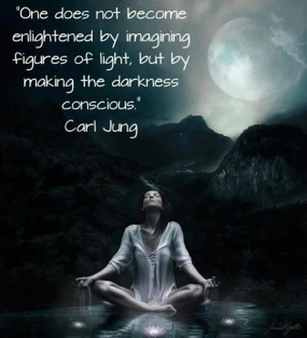 Exercise 17 - Self-Beliefs
Exercise 17 - Self-Beliefs A.) Explore something that’s really upsetting, depressing, worrying or frustrating you at the moment about yourself. Record your response below.
B) Next, think about what mistaken belief of yours might be contributing to this perceived problem.
To complete part (b), you will need to experiment with a basic self-inquiry exercise. The exercise is as follows: keep asking “why?” to the initial problem you wrote about in part (a) and you will eventually uncover your mistaken belief.
Here is an example of a worrisome issue someone might explore for part (b): “I feel ugly and fat. Why? Because no one ever compliments me and they always obsess over my best friend. Why? Because I’m overweight. Why? Because I eat too much. Why? Because I feel sad. Why? Because I feel like I’m unworthy of other’s affection.” The statement “I’m unworthy of other’s affection” is the mistaken belief here. Go as deep as you can and keep asking why until you reach an “I am [insert belief here]” statement.
Common mistaken beliefs include, “I’m not good enough,” “I am stupid,” “I am unlovable,” “I am bad and deserve to suffer,” “I am ugly,” “I am irredeemably flawed,” and the list goes on. Take your time, explore below, and reflect on your discoveries
Exercise 18 – Flaws
List two major flaws of yours that you’re embarrassed about and how they can secretly be strengths. Transforming the negative within you into a source of strength is a form of shadow integration.
Exercise 19 - Lying
What lies have you recently caught yourself telling – and how do you feel during and after telling them? (There is no right or wrong response here, it’s simply material to reflect on.)
Exercise 20 - Immaturity
In what areas of life do you behave immaturely or like a child? Carefully examine every area of your life. Record your response below. b) Next, explore what unmet needs you might be trying to receive by behaving in a childish way.
Exercise 21 - Triggers
Part 1: Reflect on the past few days. What words, feelings, beliefs, habits, actions or behaviors of others triggered a strong reaction within you? This reaction could have been extremely positive (joy, laughter, admiration) or extremely negative (anger, disgust, hatred). Write down your discoveries below.
Part 2: Next to each reaction think about times when you exhibited similar behavior to the person who triggered a strong reaction in you. Be honest and have an open mind.
Exercise 22 - Expressing Anger
What is your reaction when people express anger? Record your answer below. b) How do you think your upbringing may have influenced your reactions?
Exercise 23 - Nasty Intentions
What was the last nasty or cruel thing you wanted to say or do to someone in order to make them feel bad? Write down your response and explore your feelings about it.
Exercise 24 - Intolerance
List three things you’re intolerant about in strangers or people you don’t know well. What shadows do they reveal about you? Explore, ponder, and speculate below.
Exercise 25 - Approval
What things do you do to secretly gain approval? (Examine areas in your life where you feel good about yourself based on other’s positive reactions.
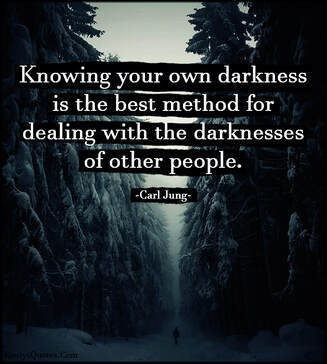 Exercise 26 - The Judge
Exercise 26 - The JudgeExplore how you play out the following role in real life:
The Judge (other names: critic, examiner). Everyone has an inner Judge – it is a necessary, fundamental part of life. Without the inner Judge we would make poor decisions, live disconnected from reality, and be incapable of self-reflection.
But when the inner Judge is too prominent in our lives, our minds are filled with harsh and critical self-talk and the impulse to condemn others. The inner Judge is a major cause of low self-esteem and is fueled by negative core beliefs and distorted thoughts.
How does the Judge show up in you? Record your reflections below.
Exercise 27 - Arguments
Think about past arguments and fights you’ve had with your partner, exes, friends, children or family members. Recall the nastiest and most serious disagreements and conflicts you’ve had. Write them down below. What were you accused of?
As always, approach this activity from a calm and neutral emotional standpoint. (If you find this activity triggers you by making you feel defensive, angry, and so forth, stop at once and do something else. Return when you feel levelheaded and try again.)
Can you find any recurring patterns in the gripes and allegations of wrongdoing others have made against you? For example, perhaps you have frequently been accused of being self-absorbed, naggy or deceitful. Write down your thoughts below and ask yourself, “could there be a shred of truth in these accusations?” Be honest. This exercise is to help you, and being dishonest to yourself only hurts you.
Exercise 28 - Attraction
Part 1: Think about what you love the most about your romantic partner or a close friend – a quality that immediately attracted or inspired you that you don’t possess. Document your response below.
Part 2: Reflect on the quality/s you just wrote about. Whatever positive trait you chose is likely a golden shadow of yours (i.e. a positive shadow quality) that you were never encouraged to develop. Below, explore how this positive quality was shut down within you as you grew up. For example, if you mentioned how much you love your partner’s artistic abilities, explore how your own inner artist was silenced or rejected growing up.
Exercise 29 - Humor
Think about your sense of humor. What do you find funny? What types of jokes make you laugh? (Your sense of humor opens a hidden door into the world of your shadow.) Styles of humor often include slapstick, self-deprecation, body-centered (e.g. sexual and toilet jokes), observational (e.g. on society), and dark comedy. What does your sense of humor reveal about an aspect of your shadow self?
Exercise 30 - Parents
What qualities in your parents do you most dislike or have trouble dealing with? What might these qualities secretly reveal about you?
Exercise 31 - Money
Part 1: Let’s explore the shadows lurking underneath your relationship with money. Answer the following questions below. Try not to think about your responses too much, just let them flow out of you naturally.
a) When I lack money I … b) When I have lots of money I … c) When someone asks me for money I … d) When the topic of money arises in my relationships I ...
Once you have journaled about these questions, do some analysis. Do any of your responses trigger feelings of guilt, shame, embarrassment, anger, or general discomfort? If so, underline the words, sentences, or concepts that put you on edge. Perhaps you will discover that you hoard, waste or ignore money. You might even find that money is tied in with your self-worth more than you thought. Whatever you underline reveals your money shadows.
Part 2: Think about the ways your money shadows have impacted your life. Explore how your financial habits, compulsions or insecurities have tainted your:
a) Friendships b) Relationships c) Self-esteem d) Self-fulfillment e) Spirituality
Answer below.
Part 3: Finally, explore three ways you can create more financial harmony in your life. Write these ideas down below and consider the easiest ways to actively incorporate them into your life across the next two months. Remember, it takes about 60 days to create a habit, so think about actionable tasks you can take every day to reverse the impact of your shadow’s perception of money. Remember: money itself isn’t evil. Money is simply a symbolic medium of exchange. Instead, it is our relationship with money that is the issue.
 Exercise 32 - Blind Spots
Exercise 32 - Blind SpotsGet an outside objective perspective on your shadows. Ask a trusted friend or loved one to reveal any blind spots, vices or imperfections you might have that you aren’t aware of.
This activity needs to be done with a calm mind, open heart, and thankful spirit. Be careful of jumping to the defense, getting angry or (worst of all) throwing insults or raging at those who are simply trying to help or enlighten you at your request. Be aware that their responses may shock, trigger or catch you off guard, so go prepared to hear the worst! Respect both your courage and theirs for choosing to share. Write down what they reveal about you below. Also record any physical, emotional, or mental reactions that you immediately noticed arise within you after hearing their feedback.
Finally, keep in mind that their feedback might be a projection of their own shadow onto you, so ideally ask for feedback from two or three trusted loved ones to get a well-rounded picture. Make sure you thank your loved one/s and give them a hug or kiss to end this activity. If it helps you to feel safe, ask your loved ones for reassurance that they still love and accept you. This activity can sometimes feel a little destabilizing, so find ways to make yourself feel safe and held by those you trust.
Exercise 33 - Ancestral Trauma
a). Reflect on any dark secrets lurking within your family and ancestral line. Think about what tragedies, scandals, addictions, horrific events or forms of abuse have occurred that your family prefers to suppress, deny or ignore. Record them below.
b) Explore how the ancestral trauma within your family has had a ripple effect on your own physical, emotional, and psychological makeup.
c) Examine how you can put an end to these ancestral shadows once and for all.
Exercise 34- Body Pain
Reflect on any sources of frequent or chronic pain in your body. What kinds of emotions may be stored within these areas? To begin this activity, connect with the part of your body that hurts, breathe deeply, and relax your mind. Ask your body, “what are you trying to tell me?” or “what do I need to know?” and wait for a response by closing your eyes and tuning in. Record any images, words, scenarios, memories or symbols you receive, below. This exercise can sometimes take a bit of practice, so don’t worry if you come up blank. Just try again when you feel ready. Storing emotional pain in the body is what psychologists call it somatization and it can reveal a lot about your buried shadows.
Exercise 35 - Shadow Letter
Give your shadow self a voice. Sit somewhere quiet and focus on your breath for a few minutes. When you are ready, light a candle, mentally envision a circle of protection around you, and tune into your inner ‘dark voice.’ If it helps you to feel more comfortable and protected, you may like to call on any higher forces you believe in to support you such as Spirit, God, Goddess, your Spirit Guides, Higher Self or Soul.
Once you feel grounded and supported, ask out loud or in your mind, “Dear Shadow, please talk to me. What would you like to tell me?” We recommend keeping a few loving affirmations ready, just in case you need to use them to counteract any overwhelming negativity that might arise. Close your eyes and write whatever pops into your mind during your shadow journaling and don’t censor any of it! Let it all come out naturally, no matter how scrambled, cryptic, disturbing, offensive or explicit it is – it’s your shadow self, remember! When the words stop flowing and you’re done, blow out the candle, and take a few moments to connect with your heart. How do you feel? Repeat your loving self-affirmations with heartfelt sincerity. Reflect on what your shadow has expressed to you below. What words, concepts or feelings jump out? These will be essential to reflect on and revisit regularly.
Whew! That’s quite a list of exercises.
Did you get through the entire list? Any “aha!” moments you’d like to share?
Keep in mind, this is just the tip of the iceberg on questions to help you identify your shadows. If you’d like the FULL workbook, go to www.lonerwolf.com.
And, as always, be kind to each other.
I’m leaving shadow work next week and celebrating all things Beltane. Fun! Flowers in your hair! And sex, of course. So put your shadow work aside and come dance around the maypole with me.
Published on April 10, 2019 18:30
April 2, 2019
The Long Bag We Drag Behind Us
 Poet and author Robert Bly wrote an essay that struck a chord with me. It explains where all the emotional baggage we’ve accumulated actually comes from. The beginning of his essay follows:
Poet and author Robert Bly wrote an essay that struck a chord with me. It explains where all the emotional baggage we’ve accumulated actually comes from. The beginning of his essay follows:The Long Bag We Drag Behind Us
“When one or two years old, most of us had 360-degree personalities. We were literally balls of energy radiating from all parts of our body and psyche. But as time went on, we noticed that our parents didn’t like certain parts of that ball. “Can’t you sit still?” Or, “It isn’t nice to hit and bite.”
“To keep our parents love, we started an invisible bag, and we put in that bag the parts of us our parents didn’t like. By the time we got to school, our bag was quite large. There, we added our teachers’ comments. “Play nice with others, don’t be bossy, don’t be so self-centered, and don’t get angry.” So we take our anger, our sense of self-importance, and put it in the bag.
“As teens, we do an extraordinary amount of bag-stuffing in high school. This time it’s no longer the evil grownup that pressures us, but people our own age. So the student’s paranoia about grownups continues.
“I so maintain that out of that round globe of energy the twenty-year-old ends up with a slice. Let’s imagine a man who has a thin slice left—the rest is in the bag—and we’ll imagine that he meets a woman. Let’s say they are both twenty-four. She has a thin, elegant slice left. They join each other in a ceremony, and this union of two slices is call marriage. Even together the two do not make up one person!
We spend our life until we’re twenty deciding what parts of ourselves to put into the bag, and we spend the rest of our lives trying to get them out again. Sometimes retrieving them feels impossible, as if the bag were sealed. Suppose the bag remains sealed—what happens then?”
~(from A Little Book on the Human Shadow, HarperCollins 1988)
I know my own son lied all through high school automatically, to try and be accepted by the most popular kids. He’s still lying to us in his 20’s, but now it’s to gain favor and avoid fights with his girlfriend, who carries an extraordinarily heavy bag.
When I read Bly’s essay, I felt like he was speaking personally about their relationship. Hell, he was also talking about me. And any number of other friends who will remain unnamed.
He warns that there is a very significant downside to repressing parts of ourselves: they begin to fester and amplify, sabotaging our lives. “Like hungry monsters clawing to get out of a dark basement, our shadows want to be brought into the light of consciousness,” Bly says. “The longer we put off facing our shadows, the more they stealthily control and manipulate our lives. Like puppets on strings, we become vulnerable to the control of our dark side in moments of anger, stress, temptation, jealousy, or tiredness. Instead of learning to meet, acknowledge, and befriend our wounded parts, we make them our mortal enemies. If you have ever felt at war with yourself or like you are your own worst enemy, it is because your shadows are controlling you, not the other way around.”
The fact is that we all have skeletons hiding in the closet and monsters lurking in the depths of our minds. We all have nasty tendencies we refuse to acknowledge, and wounds we haven’t been able to face. We all have repressed anger and unacknowledged greatness buried deep inside.
All right. I get it. There’s work to do. But…how does one know where to start?
 I’ve actually been working on my own shadow for nearly three years, and always find myself going back to a favorite book, David Richo’s Shadow Dance (I referenced his book in this current series of shadow work blogs, and also in Jan. 2017). Richo, a psychotherapist, shows how to use active mindfulness to work with our shadow side when it manifests negatively in personal life, family interaction, religion, and the world around us. He was formerly a Catholic priest, but I think the “feel” of his books is more mystical and esoteric.
I’ve actually been working on my own shadow for nearly three years, and always find myself going back to a favorite book, David Richo’s Shadow Dance (I referenced his book in this current series of shadow work blogs, and also in Jan. 2017). Richo, a psychotherapist, shows how to use active mindfulness to work with our shadow side when it manifests negatively in personal life, family interaction, religion, and the world around us. He was formerly a Catholic priest, but I think the “feel” of his books is more mystical and esoteric.He draws on his readings of the poets, Greek mythology, Hinduism, Zen, and his own experience of the Holy Spirit to illuminate the path into the dark parts of our human nature.
The book contains essays which lead you down the path of doing your “shadow work,” with each essay followed by a section of journal exercises and topics to ponder.
However, it’s not for everyone. I used to use the book for a class I taught on shadow work, and some of the students complained that Richo’s approach was overwhelming. There were a lot of tears in every class. I don’t think that’s any reflection of Richo’s teaching; looking inward and facing personal demons is hard work.
I continued to research, and I think I’ve found another source as good as Richo’s Shadow Dance, and written in down-to-earth language that divides the shadow work into more easily-understood sections.
The workbook I’ve referenced below is by Aletheia Luna and Mateo Sol. Luna is a psychospiritual counselor and writer who escaped the religious cult she was raised in, and now works to help others become conscious of their own entrapment and find empowerment. Mateo Sol was born into a family with a history of drug addiction, abuse, and mental illness, and was taught about the plight of the human condition from a young age. Sol’s mission now is to help others experience freedom, wholeness and peace in any stage of life. Together, Luna and Sol run a spiritual self-discovery website, www.lonerwolf.com .
I’m including a selection of questions from their shadow self workbook. If you’d like a copy of the entire workbook for your personal use, please go to their site.
Shadow Self Workbook
Following is a series of simple but powerful questions and activities which will help to shine a light on shadowy areas of your life that you might be unaware of. As shadow work should always be preceded by and/or incorporated with self-love, you will find some self-love activities within this journal as well.
Shadow work is an extremely deep form of inner work and should not be taken lightly. If you struggle with low self-esteem, we encourage you to focus on the self-love aspects of this journal instead. If at any time you feel intensely uncomfortable or disturbed by any shadow work activities within this journal, please stop immediately and practice self-love. Without self-love, shadow work can easily make you feel a million times worse about yourself. And we don’t want that! So always strive to incorporate self-care and nurturing self-compassion into and shadow work that you do.
Please note that not all questions within this journal will necessarily help you or be applicable. However, do pay close attention if you feel strongly tempted to skip or avoid any question – this is a sign that your shadow self has been provoked! Also be aware that it’s possible for you to project onto another person a quality that they really do possess. Psychologists call this “projecting onto reality.” So for instance, if you think your father is an out-of-control tyrant, you may be simultaneously disowning and projecting your own shadow onto your father as well as seeing him for what he actually is. However, remember that this journal is about taking responsibility for your own shadows, not pointing the finger at others. You cannot change others, but you can change yourself. Let’s leave it at that.
Exercise 1 - Playing Small
a) In what areas of life are you holding back and playing small? (Think about the times you consistently feel weak or small.) Write your answer below.
b) Try to put a face and name to the part of you that feels disempowered. What does it look like or sound like? How old is it and where did it come from? What name would it choose to call itself? Record your response below. By personifying this afraid and suppressed part of you, you’ll be more capable of understanding an important part of your shadow self.
Exercise 2 - The Saboteur
Explore how you play out the Saboteur role in real life. (Other names: destroyer, serial killer, mad scientist). At the very core of the inner Saboteur festers the desire for complete self-destruction. Fueled by self-hatred, the Saboteur within us is a wrathful companion that destroys everything beautiful within our lives. Relationships, friendships, careers, health, mental stability — nothing stands in the way of the Saboteur’s desire for self-annihilation and oblivion.
How does the Saboteur show up in you? Record your reflections below.
Exercise 3 - Negatives and Positives
What negatives or positives do others point out about you that you have trouble accepting?
Exercise 4 - Emotional Suppression
Emotional suppression and repression often point to areas of shame buried within you. Reflect on the following questions and record your answer below:
a) What emotions do you rarely express around others? b) When did you first start hiding these emotions?
Exercise 5 - Hot Buttons
What are your “hot buttons” or triggers that cause you to get angry or defensive in the presence of others?
Exercise 6 - Family Members
a) What qualities in your family members do you most dislike or have trouble dealing with?
b) What might these qualities in your loved ones secretly reveal about you?
Exercise 7 - Tolerance of Beliefs
In which areas of life do you tend to expect others to conform to your beliefs? b) What scares you the most about allowing others to have their own beliefs in the above areas?
Exercise 8 - Self-Criticism
When are you the most critical of yourself? Explore what your self-talk sounds like below.
Exercise 9 - Self-Love and Gratitude
Self-love activity: Describe five things you love about yourself and feel gratitude about. (Gratitude has been scientifically proven to enhance your happiness and wellbeing – these are important qualities to carry into shadow work).
Exercise 10 - Self-Love Letter
Self-love activity: Reflect on a period of life where you were at your worst (i.e. most self-destructive, addicted, numb, argumentative, etc.). Write a short, but heartfelt letter of understanding, acceptance, and compassion for that version of you. You can return to this letter later whenever you feel rotten about yourself.
I’ll post another 10 exercises this weekend when I conclude our month of shadow self blogs. And remember, if you’d like to delve deeper, the entire 50+ question workbook is available at www.lonerwolf.com.
Be good to yourself, and Blessed Be.
Published on April 02, 2019 19:11
March 23, 2019
Vernal Equinox and Full Moon
 Did you see the gorgeous full moon on Wednesday night? It was the vernal equinox as well. I cast circle with friends out in the desert at Apache Lake Park. We released that which no longer served us, and filled that space right back up with positive, loving vibes for the future. Such an inspiring and magical night.
Did you see the gorgeous full moon on Wednesday night? It was the vernal equinox as well. I cast circle with friends out in the desert at Apache Lake Park. We released that which no longer served us, and filled that space right back up with positive, loving vibes for the future. Such an inspiring and magical night.Normally Easter falls right after Ostara and the equinox, but this year it’s later. Did you wonder why? Well, Easter falls on the first Sunday following the first full moon following the vernal equinox. But, by ecclesiastical rules, the equinox is fixed on March 21. That mean this week’s full moon did not take place after the equinox, even though, according to astronomy, it did. The upshot is that 2019’s East Sunday will fall on April 21.
By the way, the name Easter is as pagan as it gets, named after Eostre, the virgin goddess of spring in ancient Germany. The lily, appropriated as a Christian symbol of death, was a symbol of life in pagan Greece and Rome, where it adorned Ostara altars and temples. Young men, playing the role of the lusty young God, would present them to the women they were courting. Accepting the lily meant much the same thing as accepting a diamond ring does now. And that’s why lilies are used so often in bride’s bouquets.
The idea of wearing new clothes at Easter also came from an earlier Teutonic pagan tradition. It was considered the worst of luck to wear one’s spring clothing before Ostara, and the Teutons would work through the winter in secret to prepare elegant outfits for the Sabbat celebration.
The lamb is another symbol of Ostara, and was sacred to virtually all the virgin goddesses of Europe, the Middle East, and North Africa. This symbol was so ingrained in the minds of the people of those regions that it was carried over into the spring religious rituals of the Jewish Passover and Christian Easter.
 Of course, the most pervasive symbol of Easter and Ostara festivals is the egg. Since antiquity, eggs have been the universal archetype of new life, and are carried as fertility amulets, decorated to honor deity, placed in baskets and on spring altars.
Of course, the most pervasive symbol of Easter and Ostara festivals is the egg. Since antiquity, eggs have been the universal archetype of new life, and are carried as fertility amulets, decorated to honor deity, placed in baskets and on spring altars.The modern belief that these eggs are delivered by a rabbit known as the Easter Bunny, comes from the legend of the Goddess Eostre. So much did a lowly rabbit wish to please these goddess that he laid the sacred eggs in her honor, gaily decorated them, and then humbly presented them to her. Eostre was so pleased with her gift that she ordered the rabbit to go throughout the world and deliver these little gifts of life.
If you’d like to use natural dyes for your eggs this year, try these:
Yellow-Turmeric
Orange – Paprika, onion skins (1 is enough for orange; more makes a copper color)
Red – Red onion skins, Cayenne
Violet – Purple grape juice, red raspberries, beet juice
Green – carrot tops
Blue – Blueberries
Pink – Heather
Here are the pagan meanings of the colors:
Red - new life, sexuality, root chakra, Mother Goddess, war, fire.
Orange – God, attraction, summer. Naval chakra
Yellow – Creativity, knowledge, intellect, Solar God, solar plexus chakra
Green – Earth Mother, fertility, prosperity, money, earth, heart chakra
Blue – Healing, peace, astral projection, air, spring, throat chakra
Indigo – Past lives, healing, third eye chakra
White – purification, Virgin Goddess, crown chakra
Pink – Romantic love, peace
If you celebrate Easter, consider this your holiday blessing early.
And if you just want a reason to laugh and be happy, March 25 is Hilaria, or Laughing Day in Rome. Originating from the rituals of Cybele and Attis, Laughing Day is the original Eastern Easter celebration of the resurrection of the Earth. So, go to a comedy club, laugh at least seven times, and make a joke of yourself. Just what the Goddess ordered!
Blessed Be.
Published on March 23, 2019 00:11
March 19, 2019
Difficult People
 Life would be so much easier if only we didn’t have to deal with difficult people. Have you ever felt that way?
Life would be so much easier if only we didn’t have to deal with difficult people. Have you ever felt that way?I have—for years now. Before we get together, my husband and I are given a list of ‘taboo’ topics to avoid in order to have a peaceful dinner together with one particular person. While that helps us avoid outright battle, our meetings are still tense. My difficult person steps into the room angry and on the defensive, before a word, or even a smile, is exchanged.
When people come at you with ego venom, many psychologists say the healthy response is twofold: stand up and back away. First, stand up for yourself by refusing to accept the abuse others may inflict. “Stop, I won’t be treated that way.” Or, “I understand that you disagree, but my opinion is also valid.” Then move away and move on--without having to get in the last word. To be compelled to win or to punish is to be caught in the same ego game your offender is playing.
It takes courage to stand up and say no, and it takes self-confidence to move away without a retaliatory fight.
The result of these two approaches is self-respect. But it’s not easy. And sometimes that two-pronged approach won’t work.
You may find your problem person is utterly incapable of receiving feedback or constructive criticism of any kind. She acts defensively, is determined to justify herself or to show that you are wrong or incompetent. She may not respond appropriately if you stand up for yourself. Here’s why: The ego, especially the narcissistic ego, is tone-deaf to inflection. The slightest criticisms are heard as if they were barbed. A person’s ego actually hears even gentle feedback at a higher pitch than you are using. This activates the predictable reaction of self-protection and makes hearing you impossible.
And if that vulnerable self has fragmented by reason of disappointment or betrayal, rage may arise. This is a result of uncontained—or latent contained—anger. An intact person uses healthy anger to register an “Ouch! I think I’ll avoid you in the future,” A vulnerable ego looks for a way to retaliate, to harm the person who harmed them.
Exercise : Find one example of a strong reaction that occurred this week and look for your shadow in it. Acknowledge this shadow possibility from now on, whenever you are strongly upset by something. Write it in your journal, and also share it in the moment, either with the person who incited it, or with a friend.
Punishing and Placating
Our ego often reacts to painful interactions with others in unhealthy and automatic ways. For instance, when someone snubs us or insults us, our arrogant ego may react with a plan to punish him/her with “an eye for an eye” vengeance, distancing, or sarcasm. Our ego in its victim mode on the other hand, may feel intimidated and react to such rejection with conciliatory or submissive behavior, such as giving in to someone or over compromising. Both sides of the ego are in all of us. We may punish when we are outraged, or placate when we are intimidated. Punishing masks our grief and rage; placating masks our fear.
Exercise : Find an example in our own life of holding a grudge or of attempting to get back at someone for what he/she had done to you. Instead of punishment (even the ‘silent treatment’), approach the other with love and ask for amends without blame. Regardless of whether or not the other person responds, notice how good you feel nonetheless, since you, at least, have done the loving and healthy ego thing. After practicing this for a while, it will matter less and less whether others respond as you wish. The self-expanding feelings in yourself will be sufficient reward, and you will feel better to do good than to get even.
The FACE of the neurotic ego also has a positive, creative side. We find this positive shadow side of ourselves, not by besting others, but simply by losing face.
The F for fear becomes an acknowledgement of our vulnerability while being excited by the unknown. The A of attachment becomes bonding in a committed but non possessive way. The C for control becomes power for not over others. The E for entitlement becomes speaking up and standing up for our rights, but then letting the chips fall where they may. Each feature of the FACE of ego causes pain. Fear is the first because it is the origin of the other three and because it may have happened first in our lives. We attach because we fear loss. We control because we fear grief. We demand entitlement because we fear that things may not always be fair. But there is a healthier condition than the scared-child ego: The adult ego that can work a program of change.
Everyone is occasionally rejected or intimidated. The ego takes poor treatment by others as a personal affront. Punishing and placating are neurotic attempts at controlling and avoiding the painful feelings that arise when we have to confront these normal predicaments of human existence.
The healthy alternative? Admit and feel grief, hurt and fear. Maintain self-protective boundaries in relationships, act assertively (not aggressively), and consistently override the impulse to punish or placate. Practice compassionate forgiveness, let go and move on.
Here is Richo’s list of healthy changes that occur in each of the negative features of the ego when we let go of having to act out its agenda in arrogant and neurotic ways:
As I let go of having to: I become more able to”
Get my way Cooperate with others
Be noticed and appreciated by everyone Ask for, give, and receive appreciation
Insist my misdeeds be overlooked Apologize and make amends
Insist I not be shown up or be proven wrong Do my best and be open to feedback
Be devastated if I lose face Admit an error and not let others shame me
Make demands on others Ask for what I want and be able to accept ‘no’ for an answer
Always win or be given preference Do my best, ask for rightful credit and let go
Have to get back at others Have a sense of justice without the need to punish
This list, by the way, is the basic definition of groundedness. To no longer be moved off-center by what others may do.
I’m taking a break from shadow work to celebrate Ostara, and then will conclude the shadow blogs with “The Long Bag We Drag Behind Us,” and how our shadow self developed in the first place.
Until then, be kind to each other.
Blessed Be.
Published on March 19, 2019 16:40
March 7, 2019
Shadow Work
 Forgive me.
Forgive me.I worked all last week on a blog about dealing with difficult people. It’s a subject close to home for me, and I struggled, because one of the difficult people in my life is someone I long to care for and enjoy a healthy relationship with. She and I are both failing miserably, and it’s having a negative impact on the people who love us both. I spent the week mired in research, trying to find a positive spin for my topic, and subsequently missed last Thursday’s blog post, and I apologize for the omission.
Interestingly, the further I got into the research, the more frequently I encountered the topic of “shadow self.” Our shadow selves are those dark and hidden places within us that we have refused to shine light on, for one reason or another. Everything that has happened to us in our life…every hurt, every loss, every shame, every personality trait that we have rejected or suppressed…go into our shadow self. Parts of us that we believe are unlovable, unacceptable, dangerous or taboo. It all forms what Jungian psychoanalysts call the “Shadow Self.”
Most of us prefer to suppress, deny and disown our shadow. David Richo, a psychotherapist who has written several books on this topic, calls our shadow self the FACE—Fear, Attachment, Control, and Entitlement—that we show to feel safe. Our ego is ruled by our FACE and it’s our way of disavowing our vulnerability to our conditions.
As long as we are caught in the dramas of fear and desire, we are stuck in the shadow of ego and not able to access the powers of fearless love.
Why do certain things and people upset us so much? The neurotic, inflated ego, the shadow side of the healthy ego, urges us to control others, place ourselves first at the expense of others, or punish them for daring to cross us. This ego is what makes us believe we are entitled to an exemption from the conditions of human existence. It is an arrogance that is full of the fear of grieving losses and accepting setbacks.
 Inflated ego rears its head when it is challenged. Have you ever noticed yourself reacting out of proportion to a negative stimulus you’ve encountered? A person is curt with you on the phone, and it gnaws at you all day. A driver cuts you off in traffic and you react with ‘road rage.’ A relative disagrees with you, and you decide on the spot that you hate them. What is blowing your reaction so out of proportion? Here are some possibilities:
Inflated ego rears its head when it is challenged. Have you ever noticed yourself reacting out of proportion to a negative stimulus you’ve encountered? A person is curt with you on the phone, and it gnaws at you all day. A driver cuts you off in traffic and you react with ‘road rage.’ A relative disagrees with you, and you decide on the spot that you hate them. What is blowing your reaction so out of proportion? Here are some possibilities:*Am I seeing a mirror image of myself? Am I like that driver sometimes? Is it in me to treat people that way? Do I refuse to see and consider the validity of diverse points of view on a topic? Our negative shadow contains all that we strongly detest in ourselves but cannot see. We tend to see this shadow of ourselves in others, detesting in them exactly what we disown in us. The work is to ask ourselves if what strikes us so deeply about others’ behavior is the clue to a similar trait in us. That’s the “F” in FACE.Is my arrogant ego indignant? “How dare she talk to me that way? I’ll be damned if I let her get away with this. I’ll get back at her somehow.” These statements tell us that the entitled controlling ego is enraged at not getting its way. The inflated ego has a dogged dedication to the promotion of its own self-interest, even to the detriment of others, and sometimes even itself. At any slight it becomes aroused, puffs up to full mast, and starts aggressively poking. Like the erect penis, the neurotic ego has no conscience or clarity and does not respond to rationality. This is the “E” in FACE.
The work here is to acknowledge this and forego any punitive reactions. This requires a pause between action and reaction. Such mindfulness grants us the freedom to choose a response from a vast repertory, rather than revert to the automatic settings of ego.
The curtness you met with today may trigger a reminder of a similar wound from the past. You feel hurt and powerless, a signal that your inner child has come to the forefront of your consciousness, to show you where you still feel hurt or afraid. This is the “A” reaction in FACE. The work is to grieve the past hurt by letting feelings about it arise, feel it fully, acknowledge it as legitimate, and then consciously decide it will not prevent you from getting on with your life. Carl Jung says, “We meet ourselves time and again in a thousand disguises on the path of life.” In fact, he says, we never truly see others. Instead, we see only aspects of ourselves in them.”
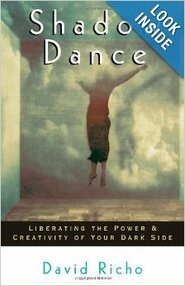 In his book, “Shadow Dance,” David Richo includes a list: “What the Shadow of the Ego Sounds Like.”
In his book, “Shadow Dance,” David Richo includes a list: “What the Shadow of the Ego Sounds Like.”Are any of the following sentences a characteristic of you? Do you know others who fit this list?
* Everyone has to acknowledge my superiority* If I am wronged, someone will pay for it* Rules don’t apply to me* How dare you question me?* It won’t be done right unless I do it* I deserve a special deal* I become explosive if crossed* I’m never wrongI cannot tolerate having to ask or learn from anyoneHow dare you not realize: I have to get my way
You have to do it my way
You cannot override my decisions, think for yourself, or act on your own if you want to be close to me.I can’t be shown up or shown to be wrongI have to be excused for every mistakeI may be highly insulted by the least slightI have to get the last word in. Or storm outI can make demands on you but you cannot make demands on me.I have to be loved, be respected, and given preferential treatment by everyone, all the time, no matter what! Otherwise, I’ll have to get back at you.
Richo points out the words have to and how they reveal the compulsive element of ego reactions. This is the opposite of the pause that makes free choice and new alternatives possible.
The way to tell if the sentences listed above are operative in you is to ask, “Can I take what happens simply as information?” If so, you can speak up assertively, refuse to accept abuse, and still feel compassion for people who believe they have to be mean. Events will elicit feelings that you express, but you can let go of them soon and move on. You are not so strongly affected that you lose your own groundedness or boundaries, and you hold no grudges. Furthermore (and I personally think most important), you can receive feedback and even criticism as information rather than as a threat.
Your healthy ego may be rankled by an injustice, but you assess your power to handle it and act accordingly. You see a need and mindfully devise a resource to meet it. Out of control or inappropriate reactions point to where your work is. In fact, this is how overreactions to others can become valuable information about yourself.
Thank you, David Richo, for giving me a more in-depth perspective of the shadow self. I realize now that I have some “A” traits in my FACE to work on, some of them newly recognized, some well-known but still prickly.
Is there a part of this article that rings especially true with you? Or do you have someone in your life that can check off every one of those “have to” phrases? If so, tune in next Thursday. I’ll be back to tackle dealing with difficult people topic, with Mr. Richo’s help.
Blessed Be, and Happy Saint Pats!
Published on March 07, 2019 16:37



